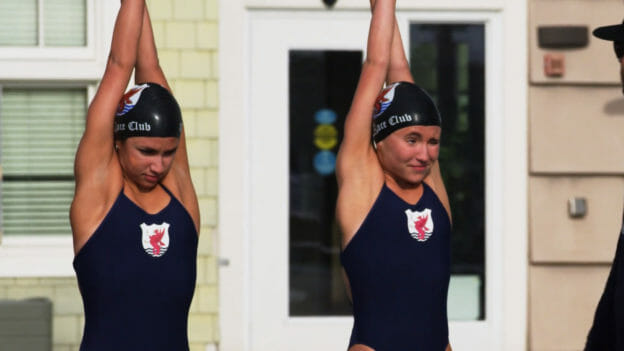The Three Techniques of a Clean Entry for Swimming Race Starts
When a swimmer’s hands first strike the water on the swimming start, the speed of the swimmer will never reach anywhere near that level again in the race. Whether a swimmer simply falls off the block or has a huge vertical leaping ability, like Caeleb Dressel or Brad Tandy, the vertical speed at hand entry will be similarly near 13-14 mph, thanks to gravity. Both swimmers will also reach the water at exactly the same time. The difference is that Caeleb and Brad will reach the water over 4 meters from the wall.
When Caeleb swims the 50 freestyle, his average speed is about 5.5 mph. As the hands enter the water after the start, swimmers are traveling at nearly 3 times the world record speed. Since frontal drag is proportional to the square of the speed of the swimmer, the swimmer had better find the most streamlined position possible. If not, he or she will pay a huge penalty.
One of the most important techniques of a great swimming start is to not lose all of that momentum derived from the high velocity off the starting block. To do so requires a very clean entry, which means very little splash. The bigger the splash, the more frontal drag is caused at entry, and the more the swimmer slows down.
The three importance techniques or nuances of getting a clean entry at the swimming race start are:
- Hyperstreamline the front end of your body
- Point the toes at entry with a very slight knee bend
- Lift the hip before entry
We have written extensively about the use of the hyperstreamline position in swimming:
- Teaching and Learning Fundamentals: Begin with Streamline
- Physics for Swimmers, Coaches, and Parents – Frontal Drag
- What is the Best Streamline
- Freestyle Flip Turn: Why the Breakout Matters
It is interesting to note that, although there continues to be some controversy about the best way for swimmers to streamline, virtually all swimmers get into the hyperstreamlined body position for the entry off the swimming race start. Chins are tucked all the way to the chest. Arms are placed behind the head and hands are wrapped together, wrist over wrist, with fingers pointed forward and squeezed together. At such high speeds that are achieved on the starts, swimmers have learned that this hyperstreamlined body position results in the lowest possible drag coefficient.
What swimmers are not so aware of is what is happening at the back ends of their bodies, with their feet and legs. The feet and legs enter the water at nearly the same speed as the hands, yet swimmers are often simply unaware of what is happening at that end. Failing to point the toes is one of the most common mistakes we find on the start. With our Propulsion/Drag Meter testing, we found that having the feet hanging will add 41% more frontal drag compared to pointing the toes. In other words, if your feet are hanging down on the start, it is like putting a parachute out.
In order to get the feet in the water cleanly, the toes need to be pointed backwards like a ballerina and the knees should be bent very slightly. Bending the knees slightly enables the swimmer to point the toes skyward and to slip the feet into the water with very little splash. Overbending the knees results in too much frontal drag from the legs and not bending them at all results in the feet being too horizontal at entry. Getting the legs and feet into the water cleanly will result in the swimmer sustaining greater momentum.
Finally, the third important technique involved in getting the body into the water cleanly is called the hip lift. With this technique, the swimmer flexes the hip slightly (about 15 degrees) just prior to entry. If the swimmer maintains a straight body line at entry, the swimmer tends to go too deep. If the swimmer over flexes the hip (more than 30 degrees), he also tends to go too deep. With the right amount of hip flexion, the swimmer can get into the water with the least amount of drag and at the right depth. Virtually all elite swimmers will lift their hips slightly just before entering the water on the start.
This week in Lanes 2, 3 and 4 of The Race Club subscription, you will see a video on how we progress our swimmers through the process of getting a clean entry for the swimming start. Learning these three important techniques of a clean swimming race start entry is the first step toward getting a fast start like Caeleb and Brad have. We hope you enjoy!
Since Race Club strength coach Tim McClellan began using Martial Arts techniques to teach our elite sprinters how to gain swimming power, speed and coordination in 2000, we have believed strongly in these types of exercises to benefit swimmers. This week in Lanes 1-4 (complimentary) you will find a fascinating combination of strength exercises using Martial Arts by Coach Coley Stickles with his Indiana University post-graduate athletes. You will love this video!
Subscribers to Lanes 3 and 4 will enjoy a deeper-dive video into some of the many boxing exercises that Coley uses for his athletes.
Yours in Swimming,
Gary Sr.
Strength Training for Swimmers – Coach Coley Stickels Indiana University


1
555
14pTJTvGm
1′”
555nicy3kks
555*1
-1 OR 2+723-723-1=0+0+0+1
555′”